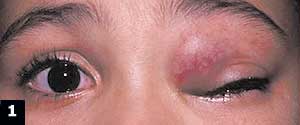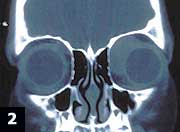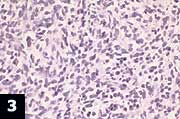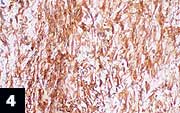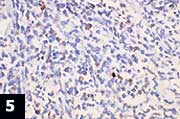Young patient referred with eyelid mass
Initially diagnosed as a “stye,” the mild swelling had progressed rapidly to a 2-cm body that displaced the globe.
|
A 7-year-old girl was transferred from an outside hospital to New England Eye Center for evaluation of a left upper lid mass (figure 1). Three weeks before presentation, the patient’s mother noted mild swelling of her daughter’s medial left upper lid. Their primary care physician told them it was a “stye” and the patient was prescribed cephalexin 500 mg by mouth three times a day for 10 days and warm compresses. Over the next 3 weeks the swelling rapidly progressed without pain, fever or discharge.
The patient was the product of a healthy, full-term pregnancy with normal spontaneous vaginal delivery. She had no significant medical or ocular history. She took no med- ications and had no known drug allergies. The family history was non- contributory.
Upon examination, visual acuity was 20/30 in the right eye and 20/70 + in the left eye with limited effort. The pupils were dilated from her earlier exam at the outside facility. The intraocular pressures by applanation tonometry were 9 mm Hg in the right eye and 11 mm Hg in the left eye.
Extraocular movements were full in the right eye, with movement limited to 60% superonasally in the left eye. There was a rubbery mass measuring approximately 2 cm in height by 1.5 cm in width, with fine vessels on the overlying skin, at the medial aspect of her left upper lid. The globe was displaced inferiorly. The remainder of her anterior segment and dilated fundus exam was otherwise normal in both eyes. Preauricular and cervical lymphadenopathy was absent, and her cardiac, lung and abdominal exams were also normal.
Young patient with eyelid mass
|
Rhabdomyosarcoma, a mesenchymal tumor, presents most often as a rapid unilateral proptosis in a 7- to 8-year-old child, with a tendency to affect the superonasal quadrant. This important diagnosis needs rapid workup and treatment. Other differentials include metastatic tumors such as leukemia and neuroblastoma, which can both exhibit proptosis and orbital ecchymosis. Encephaloceles or meningioceles are ectopic tissue masses that can manifest with proptosis or downward displacement of the globe. The intracranial tissue, which can be herniated through bony defects, appears as a subcutaneous mass most often above medial canthal ligament.
In the infectious category, sinus mucocele, chalazion or cellulitis should be considered. An inflammatory etiology such as orbital pseudotumor is possible but usually presents with pain in older children. A dermoid cyst is a congenital tumor that usually progresses slowly and is most often located at the lateral brow. However, the appearance of rapid growth can occur if cyst rupture and leakage of its oil and keratin contents produces inflammation.
Vascular tumors such as capillary hemangioma or lymphangioma can also be found in the lids and orbits of children. Capillary hemangioma, usually seen within the first year of life, has a propensity for the superonasal orbit and medial lid and can grow rapidly. Known for its strawberry appearance when close to the skin, it can take on a bluish hue when located within the orbit. A lymphangioma may also present acutely if there is hemorrhage from its capillaries leading to a chocolate cyst.
Clinical course
A CT scan performed on the patient revealed a 2 cm by 2.8 cm by 2.7 cm extraconal mass in the superior medial left orbit. The mass was well-circumscribed and conformed to shape of globe (figure 2). Because of the strong suspicion that this patient had rhabdomyosarcoma, a left anterior orbitotomy with biopsy and anterior debulking was performed that evening.
Pathologic evaluation revealed numerous undifferentiated, poorly oriented, small, round and some spindly cells with hyperchromatic nuclei and indistinct cytoplasm (figure 3). There were numerous mitotic figures, and the specimen was immunoreactive with vimentin (mesodermal origin, figure 4) and desmin (muscle, figure 5). The picture was most consistent with rhabdomyosarcoma, embryonal type.
The patient was transferred to a pediatric oncology service at a hospital closer to her home. A chest CT, bone marrow aspirate and biopsy, bone scan and lumbar puncture were all normal. Vincristine and actinomycin treatments were started, and radiation treatments are scheduled to start soon. The size of the orbital mass has already dramatically decreased.
|
|
|
Discussion
Rhabdomyosarcoma is the most common primary pediatric orbital malignancy. This mesenchymal tumor can originate from many different areas of the body including the orbit (10%), head and neck excluding orbit (25%), genitourinary (23%) and extremities (17%). It also originates in smaller percentages from the trunk, retroperitoneum, chest, perineum and gastrointestinal tract.
The classic clinical presentation is that of a 7- or 8-year-old child with a rapidly progressive unilateral pro-ptosis. A palpable mass in the superonasal quadrant, edema and discoloration of eyelid, ptosis and displacement of the globe may also be present.
Diagnostic testing should proceed promptly, given the often extremely rapid growth of rhabdomyosarcoma tumors. A CT scan or MRI should be performed to rule out other etiologies in the differential diagnosis, and then a biopsy is required for def- initive diagnosis. Preauricular and cervical lymph nodes are examined for regional metastasis, followed by a chest x-ray or chest CT, bone marrow aspirate and biopsy and lumbar puncture to evaluate for distant metastasis.
The most common histopathologic group is embryonal, which is often located in the superonasal quadrant of the orbit. Alveolar, the next most common, is often in the inferior orbit and has a poor prognosis. Botryoid type is rare, having a “grape-like” appearance and subconjunctival location. Pleomorphic type, the most rare, is well differentiated, occurs in older individuals and portends the best prognosis.
Standard treatment is combined chemotherapy (usually vincristine and actinomycin for 1 year) and orbital radiation (usually 4,500 to 6,000 rads given over 6 weeks). The late effects of treatment are many, including decreased vision, optic neuropathy, radiation retinopathy, cataract, radiation dermatitis, bony hypoplasia, dry eye, chronic keratitis, conjunctivitis, nasolacrimal duct obstruction, neuroendocrine dysfunction and secondary tumors.
The prognosis with current treatment is excellent. Today there is more than a 90% survival rate compared with only a 25% to 35% survival rate in 1970. Prior to current treatment, rhabdomyosarcoma of the orbit was managed with exenteration, a treatment currently reserved for rare cases of recurrence. There is a worse prognosis with tumor spread into paranasal sinuses and parameninges.
For Your Information:References:
- Emma Massicotte, MD, and Katrinka Heher, MD, can be reached at New England Eye Center, Tufts University School of Medicine, 750 Washington St., Box 450, Boston, MA 02111; (617) 636-4219; fax: (617) 636-4866.
- Waram M, Beltangady M, et al. Localized orbital rhabdomyosarcoma. An interim report of the Intergroup Rhabdomyosarcoma Study Committee. Ophthalmology. 1987;94:251-254.
- Crist W, Gehan EA, et al. The Third Intergroup Rhabdomyosarcoma Study. J Clin Oncol. 1995;13: 610-630.
- Mannor GE, Rose GE, et al. Multidisciplanary management of refractory orbital rhabdomyosarcoma. Ophthalmology. 1997;104:1198-1201.
- Paulino AC, Simon JH, et al. Long term effects in children treated with radiotherapy for head and neck rhabdomyosarcoma. Int J Rad Onc, Biology, Physics. 2001;48:1489-95.
- Raney RB, Anderson JR, et al. Late effects of therapy in 94 patients with localized rhabdomyosarcoma of the orbit: Report from the Intergroup Rhabdomayosarcoma Study. Medical and Pediatric Oncology. 2000;34:413-420.
- Mafee MF, Pai E, Philip B. Rhabdomyosarcoma of the orbit. Evaluation with MR Imaging and CT. Radiologic Clinics of North America. 1998;36:1215-1227.
- Jakobiec FA, Bilyk JR, Hidayat AA. Mesnchymal, Fibroosseous, and Cartilaginous Orbital Tumors in Principals and Practice of Ophthalmology, Albert and Jakobiec, 2nd Ed., editors: Albert DM, Jakobiec FA, et al. Philadelphia, PA: WB Saunders Company; 2000: 3296-3304.

